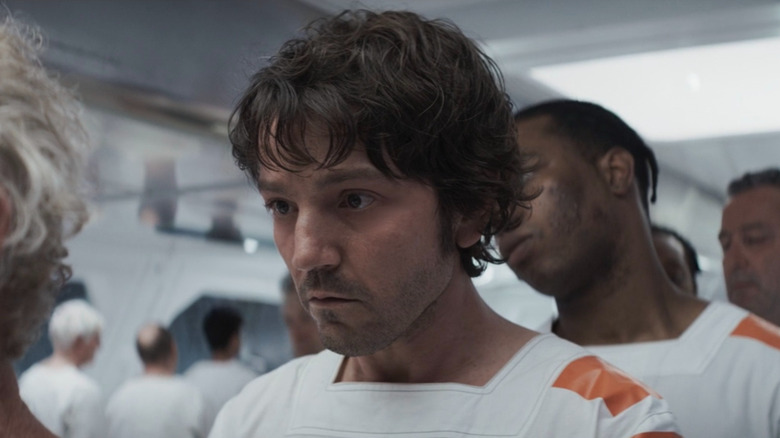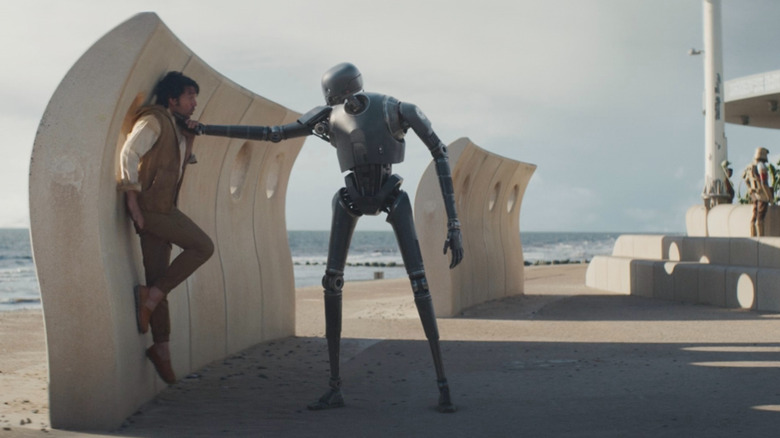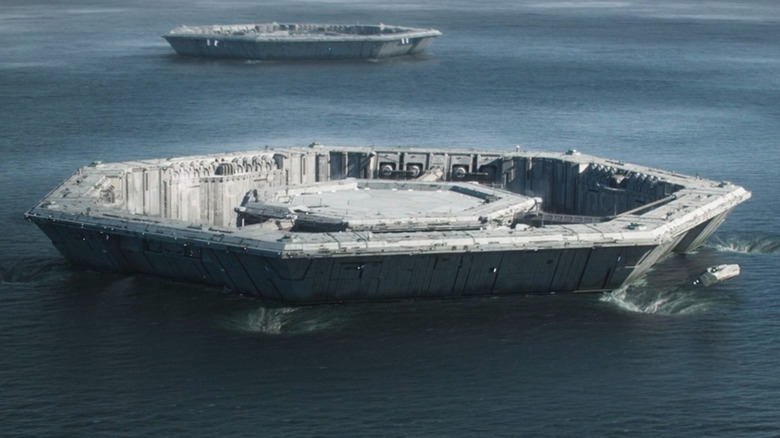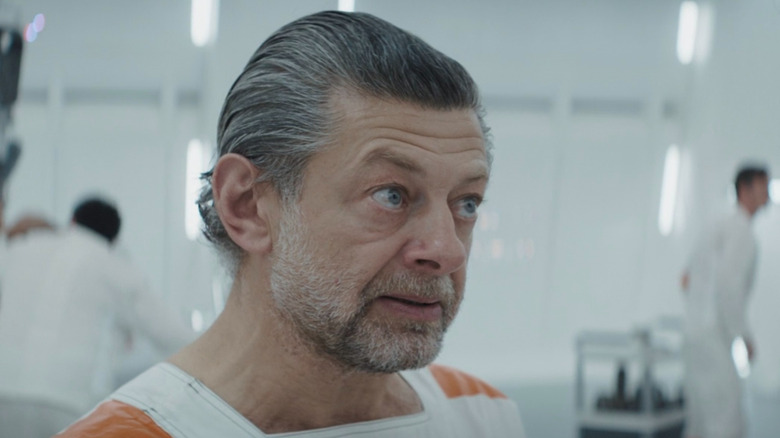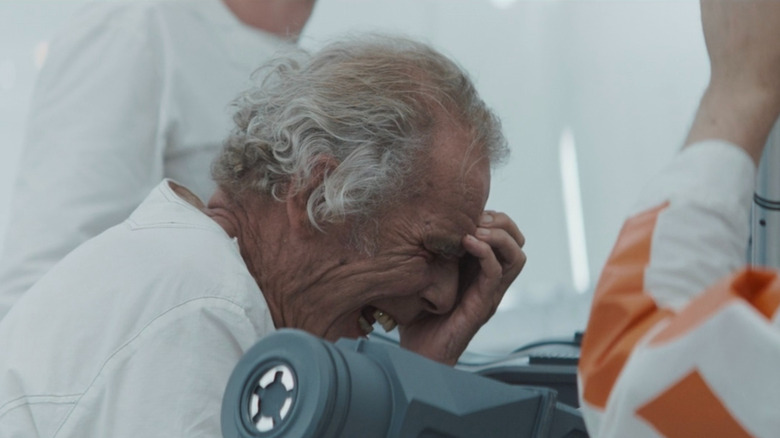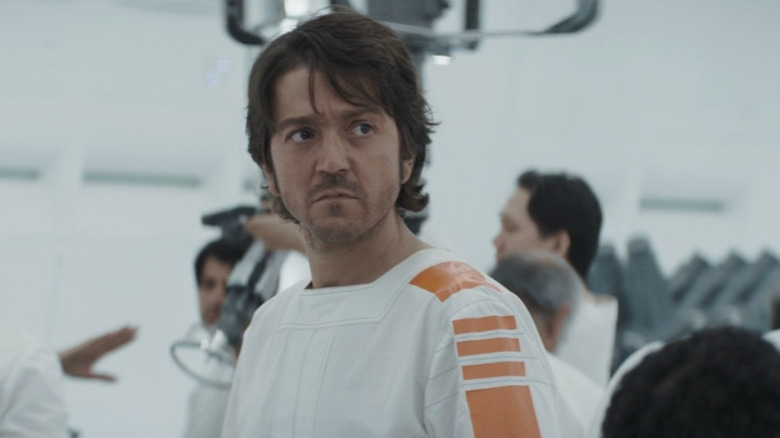The Daily Stream: Andor's Prison Scenes Put THX 1138 And Clerks In A Dystopian Work Blender
(Welcome to The Daily Stream, an ongoing series in which the /Film team shares what they've been watching, why it's worth checking out, and where you can stream it.)
The Series: "Andor"
Where You Can Stream It: Disney+
The Pitch: You've seen "Star Wars" as a space opera, founded on "A New Hope." Here's what it looks like as a dystopian, sci-fi, prison work culture.
As the umpteenth "Andor" article on the interweb since the show's premiere, you have no reason to read this, and the recent episode title, "Nobody's Listening," has already prepared this writer for the likelihood that any further thoughts will — as the warden of Shawshank State Prison once put it — quickly up and vanish "like a fart in the wind." But I'm going to go ahead and load them up in a pneumatic tube, anyway, and send it along like a message in a bottle from a watery space prison.
"Andor" juggles multiple storylines every week, but if unofficial "Star Wars" editor Topher Grace, or maybe just some Force-sensitive YouTuber, could splice together the end of episode 7 and all the prison scenes from episodes 8 and 9, they'd have a harrowing, high-concept, almost self-contained plunge into a penal colony, with real-world parallels the likes of which "Star Wars" hasn't seen since the Viet Cong inspired the Ewoks in "Return of the Jedi."
As /Film's Bryan Young has noted, the setting looks and sounds a lot like the all-white prison in "THX 1138," the abstract, R-rated, feature-length directorial debut of one George Lucas. Yet it also shows the kind of hidden figures of "Star Wars" that Kevin Smith's "Clerks" speculated about back in the mid-1990s.
Why it's essential viewing
"Andor" is the rare slice of "Star Wars" entertainment with something to actually say about the world we live in, as opposed to just being a Muppet Baby prequel steeped in fantasy and content to "rhyme" with the beats of past stories. It's a "Star Wars" tale where the usual farm-boy idealism gives way to an utterly hopeless situation, though we know from movie canon that Cassian Andor, like Andy Dufresne in "Shawshank," will someday have a life beyond prison.
Since 2017, we've seen the Chosen One myth deconstructed in "Star Wars: The Last Jedi," then awkwardly reconstructed in "The Rise of Skywalker." But five years later, there remains a kernel of social relevance to the idea that anyone can be a Jedi, even a broom boy. "Andor" finally gets us away from Skywalkers and Jedi and into a corner of the "Star Wars" universe that's more relevant to 21st-century life than any of the other increasingly esoteric lore coming out of the franchise. If only more people were watching it.
A long time ago, in an indie movie far, far away, the Death Star contractors scene in "Clerks" asked us to imagine moral complexity and unsung working-class stories behind-the-scenes in "Star Wars." "Andor" does something similar by showing the Empire as a kind of corporate nightmare with indentured servants, one of whom landed where he is not through Jedi valor but through mercenary involvement in a Rebel heist.
Cassian Andor (Diego Luna) just wants to escape to a nice beach planet, one that isn't going to be nuked from above by a Death Star and one where an Imperial enforcer droid isn't going to seize him in a one-handed chokehold. Wouldn't we all?
'Assessed as labor-worthy'
Our first introduction to Cassian in "Rogue One: A Star Wars Story" saw him gunning down an injured informant who had just provided him valuable intel about the Empire's development of "a planet killer." (They seem to have a lot of those, but this was the original Death Star.) He did it to make a quick getaway and — according to Marvel, which published the "Rogue One" comic book adaptation — "to prevent the Imperials from learning what the Rebels knew about the Death Star." Whatever the justification, it was a moment that challenged the notion of "Star Wars" Rebels as strict "good guys."
Cassian, or Keef, as he presently calls himself, has continued gunning men down in "Andor." And now, through sheer intragalactic karma, perhaps (since the official charges are drummed up based on him just walking suspiciously and protesting that he's a tourist), it's led to him being casually sentenced to six years in Narkina 5, a place described as an "Imperial factory facility" with "floors of Tungstoid steel." Like Dante Hicks (Brian O'Halloran) in "Clerks," he's not even supposed to be there.
"Assessed as labor-worthy" by the Empire's welcoming committee, Cassian/Keef's unwitting descent into this hellhole and honeycomb of a prison sees him stuck on an assembly line where everything and everyone is quantified, the way workers' lives are in "THX 1138." Forget the idea of a sign with the number of days since the last accident on-site; in that film, it's considered a victory when only 195 lives are lost.
The not-so-funny thing is, "THX 1138" reads like a license plate number — the kind of item real-life prison inmates would be forced to make — and a variation on it later would show up as a plate on one of the hot rods in "American Graffiti."
Machine men making machine parts
We've discussed before how the DNA of "THX 1138" is present in every "Star Wars" film. The movie ends where "American Graffiti" begins, with a sunset, as Robert Duvall's character comes up from the underground proto-Death Star, into the light of a red, Tatooine-like dusk. You see him hesitating as he climbs the ladder to freedom; a silver-faced police android tells him this is his "last chance to return" willingly to a subterranean realm where humanity is oppressed by technology. In a way, Lucas himself would do that with green screen in the "Star Wars" prequel trilogy, as if his immediate escape to his hometown of Modesto, California, in "American Graffiti" were only a bit of work release.
Though "Andor" lacks the bald androgynous heads of "THX 1138," its workers are clad in similar white, forced to compete as dehumanized factory drones in the prison-industrial complex. We see them making machine parts, Imperial widgets of some sort, but they themselves also become part of the machinery. We get a sense of how they're compartmentalized in multiples of seven across different levels, tables, and rooms, with each factory kept apart from the other ones by a gulf of sign language through space windows.
Cassian works a 12-hour shift where "productivity is encouraged, evaluation is constant," and 39-minute sprint segments are routine. Supreme Leader Snoke himself, Andy Serkis, shows back up in the franchise as a different character, Cassian's grizzled floor manager, who bears the very "Star Wars" name of Kino Loy. When Cassian's Imperial captors first drop him off on Level 52D, Kino notes, "They only come to pick up the dead and bring their replacements."
Nameless and numbered
These last two sections contain spoilers for "Andor," season 1, episode 9.
In "Clerks," video store clerk Randal Graves (Jeff Anderson) theorizes that a construction job of the Death Star's magnitude "would require a helluva lot more manpower than the Imperial army had to offer." He says, "I'll bet they brought in independent contractors on that thing. Plumbers, aluminum siders, roofers..."
"Andor" suggests the Empire could have just brought in prisoners, men whose lives they deemed expendable. The "innocent contractors" Randal talks about, all those hypothetical workers who became "casualties of a war they had nothing to do with," were maybe just guys like Cassian, Kino, and Ulaf (Christopher Fairbank), the old-timer or "short-timer" who has a massive stroke just 40 shifts shy of his supposed release. The doctor who euthanizes Ulaf doesn't want to know his name, which seems to be a pattern among the inmates, just as it was for the nameless, numbered people of "THX 1138."
Note how one of the other men at Cassian's busy worktable calls him "New Guy" and has to be reminded of his name right after he first introduces himself. Not seeing the person across from them is a way for some, like the doctor, to inure themselves against their own lost humanity and powerlessness to help anyone. It's so bad that, in the cell block where the men sleep and suck down gruel from tubes, one guy's lifeless body on the floor immediately gets minimized to an inconvenience that will leave his fellow inmates "shorthanded all day tomorrow."
'Just another day, another shift'
For his part, Kino is as much a prisoner as Cassian, operating under the illusion that he'll soon work off the remaining 249 days of his sentence like Wookie life debt. It's all a lie, though, because no one ever gets out of the prison; they're simply transferred to another level, where they start all over again with a fresh sentence. But Kino doesn't know that yet, and in the meantime, he takes pride in how he has "a free hand in running" his room, which is usually "in the top 3" on his level.
Initially, Cassian only holds Kino's attention for the utilitarian value he brings to the room. There's even a moment where we get the "Star Wars" version of a shift leader saying, "If you've got time to lean, you've got time to clean," as Kino spots Cassian leaning and barks, "Hey! You just takin' a breather? C'mon, guys! You got a chance of winning the shift today!" He's less interested in anyone's welfare and more interested in crunching the numbers. "Losing hope, your mind?" Kino says. "Keep it to yourself."
As Forbes notes, almost half of all employees in Generation Z "say they are stressed or anxious all or most of the time" at work. The uptick in remote work during the pandemic makes it even easier for colleagues to barely register as a blip on each other's radar, like the end of that one "Black Mirror" episode where the whole dramatic hostage situation gets reduced to a fleeting notification on social media.
"Star Wars" has traditionally been an aspirational story, but in "Andor," it speaks to the ugly truth of today's workplaces, and we can only hope — yes, hope — that Cassian and company will soon make a much-needed prison break.
